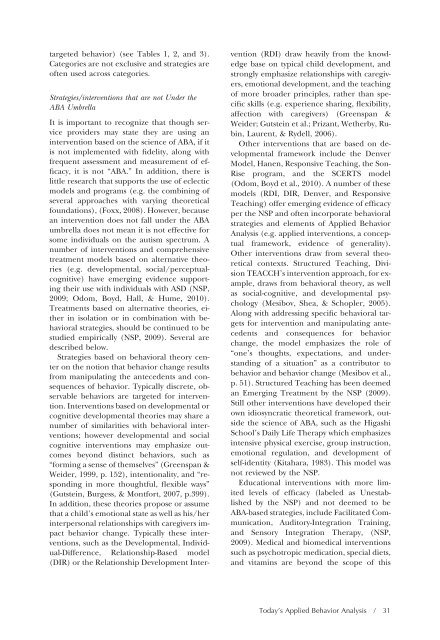Beyond Time Out and Table Time - Division on Autism and ...
Beyond Time Out and Table Time - Division on Autism and ...
Beyond Time Out and Table Time - Division on Autism and ...
You also want an ePaper? Increase the reach of your titles
YUMPU automatically turns print PDFs into web optimized ePapers that Google loves.
targeted behavior) (see <str<strong>on</strong>g>Table</str<strong>on</strong>g>s 1, 2, <str<strong>on</strong>g>and</str<strong>on</strong>g> 3).<br />
Categories are not exclusive <str<strong>on</strong>g>and</str<strong>on</strong>g> strategies are<br />
often used across categories.<br />
Strategies/interventi<strong>on</strong>s that are not Under the<br />
ABA Umbrella<br />
It is important to recognize that though service<br />
providers may state they are using an<br />
interventi<strong>on</strong> based <strong>on</strong> the science of ABA, if it<br />
is not implemented with fidelity, al<strong>on</strong>g with<br />
frequent assessment <str<strong>on</strong>g>and</str<strong>on</strong>g> measurement of efficacy,<br />
it is not “ABA.” In additi<strong>on</strong>, there is<br />
little research that supports the use of eclectic<br />
models <str<strong>on</strong>g>and</str<strong>on</strong>g> programs (e.g. the combining of<br />
several approaches with varying theoretical<br />
foundati<strong>on</strong>s), (Foxx, 2008). However, because<br />
an interventi<strong>on</strong> does not fall under the ABA<br />
umbrella does not mean it is not effective for<br />
some individuals <strong>on</strong> the autism spectrum. A<br />
number of interventi<strong>on</strong>s <str<strong>on</strong>g>and</str<strong>on</strong>g> comprehensive<br />
treatment models based <strong>on</strong> alternative theories<br />
(e.g. developmental, social/perceptualcognitive)<br />
have emerging evidence supporting<br />
their use with individuals with ASD (NSP,<br />
2009; Odom, Boyd, Hall, & Hume, 2010).<br />
Treatments based <strong>on</strong> alternative theories, either<br />
in isolati<strong>on</strong> or in combinati<strong>on</strong> with behavioral<br />
strategies, should be c<strong>on</strong>tinued to be<br />
studied empirically (NSP, 2009). Several are<br />
described below.<br />
Strategies based <strong>on</strong> behavioral theory center<br />
<strong>on</strong> the noti<strong>on</strong> that behavior change results<br />
from manipulating the antecedents <str<strong>on</strong>g>and</str<strong>on</strong>g> c<strong>on</strong>sequences<br />
of behavior. Typically discrete, observable<br />
behaviors are targeted for interventi<strong>on</strong>.<br />
Interventi<strong>on</strong>s based <strong>on</strong> developmental or<br />
cognitive developmental theories may share a<br />
number of similarities with behavioral interventi<strong>on</strong>s;<br />
however developmental <str<strong>on</strong>g>and</str<strong>on</strong>g> social<br />
cognitive interventi<strong>on</strong>s may emphasize outcomes<br />
bey<strong>on</strong>d distinct behaviors, such as<br />
“forming a sense of themselves” (Greenspan &<br />
Weider, 1999, p. 152), intenti<strong>on</strong>ality, <str<strong>on</strong>g>and</str<strong>on</strong>g> “resp<strong>on</strong>ding<br />
in more thoughtful, flexible ways”<br />
(Gutstein, Burgess, & M<strong>on</strong>tfort, 2007, p.399).<br />
In additi<strong>on</strong>, these theories propose or assume<br />
that a child’s emoti<strong>on</strong>al state as well as his/her<br />
interpers<strong>on</strong>al relati<strong>on</strong>ships with caregivers impact<br />
behavior change. Typically these interventi<strong>on</strong>s,<br />
such as the Developmental, Individual-Difference,<br />
Relati<strong>on</strong>ship-Based model<br />
(DIR) or the Relati<strong>on</strong>ship Development Inter-<br />
venti<strong>on</strong> (RDI) draw heavily from the knowledge<br />
base <strong>on</strong> typical child development, <str<strong>on</strong>g>and</str<strong>on</strong>g><br />
str<strong>on</strong>gly emphasize relati<strong>on</strong>ships with caregivers,<br />
emoti<strong>on</strong>al development, <str<strong>on</strong>g>and</str<strong>on</strong>g> the teaching<br />
of more broader principles, rather than specific<br />
skills (e.g. experience sharing, flexibility,<br />
affecti<strong>on</strong> with caregivers) (Greenspan &<br />
Weider; Gutstein et al.; Prizant, Wetherby, Rubin,<br />
Laurent, & Rydell, 2006).<br />
Other interventi<strong>on</strong>s that are based <strong>on</strong> developmental<br />
framework include the Denver<br />
Model, Hanen, Resp<strong>on</strong>sive Teaching, the S<strong>on</strong>-<br />
Rise program, <str<strong>on</strong>g>and</str<strong>on</strong>g> the SCERTS model<br />
(Odom, Boyd et al., 2010). A number of these<br />
models (RDI, DIR, Denver, <str<strong>on</strong>g>and</str<strong>on</strong>g> Resp<strong>on</strong>sive<br />
Teaching) offer emerging evidence of efficacy<br />
per the NSP <str<strong>on</strong>g>and</str<strong>on</strong>g> often incorporate behavioral<br />
strategies <str<strong>on</strong>g>and</str<strong>on</strong>g> elements of Applied Behavior<br />
Analysis (e.g. applied interventi<strong>on</strong>s, a c<strong>on</strong>ceptual<br />
framework, evidence of generality).<br />
Other interventi<strong>on</strong>s draw from several theoretical<br />
c<strong>on</strong>texts. Structured Teaching, <str<strong>on</strong>g>Divisi<strong>on</strong></str<strong>on</strong>g><br />
TEACCH’s interventi<strong>on</strong> approach, for example,<br />
draws from behavioral theory, as well<br />
as social-cognitive, <str<strong>on</strong>g>and</str<strong>on</strong>g> developmental psychology<br />
(Mesibov, Shea, & Schopler, 2005).<br />
Al<strong>on</strong>g with addressing specific behavioral targets<br />
for interventi<strong>on</strong> <str<strong>on</strong>g>and</str<strong>on</strong>g> manipulating antecedents<br />
<str<strong>on</strong>g>and</str<strong>on</strong>g> c<strong>on</strong>sequences for behavior<br />
change, the model emphasizes the role of<br />
“<strong>on</strong>e’s thoughts, expectati<strong>on</strong>s, <str<strong>on</strong>g>and</str<strong>on</strong>g> underst<str<strong>on</strong>g>and</str<strong>on</strong>g>ing<br />
of a situati<strong>on</strong>” as a c<strong>on</strong>tributor to<br />
behavior <str<strong>on</strong>g>and</str<strong>on</strong>g> behavior change (Mesibov et al.,<br />
p. 51). Structured Teaching has been deemed<br />
an Emerging Treatment by the NSP (2009).<br />
Still other interventi<strong>on</strong>s have developed their<br />
own idiosyncratic theoretical framework, outside<br />
the science of ABA, such as the Higashi<br />
School’s Daily Life Therapy which emphasizes<br />
intensive physical exercise, group instructi<strong>on</strong>,<br />
emoti<strong>on</strong>al regulati<strong>on</strong>, <str<strong>on</strong>g>and</str<strong>on</strong>g> development of<br />
self-identity (Kitahara, 1983). This model was<br />
not reviewed by the NSP.<br />
Educati<strong>on</strong>al interventi<strong>on</strong>s with more limited<br />
levels of efficacy (labeled as Unestablished<br />
by the NSP) <str<strong>on</strong>g>and</str<strong>on</strong>g> not deemed to be<br />
ABA-based strategies, include Facilitated Communicati<strong>on</strong>,<br />
Auditory-Integrati<strong>on</strong> Training,<br />
<str<strong>on</strong>g>and</str<strong>on</strong>g> Sensory Integrati<strong>on</strong> Therapy, (NSP,<br />
2009). Medical <str<strong>on</strong>g>and</str<strong>on</strong>g> biomedical interventi<strong>on</strong>s<br />
such as psychotropic medicati<strong>on</strong>, special diets,<br />
<str<strong>on</strong>g>and</str<strong>on</strong>g> vitamins are bey<strong>on</strong>d the scope of this<br />
Today’s Applied Behavior Analysis / 31
















